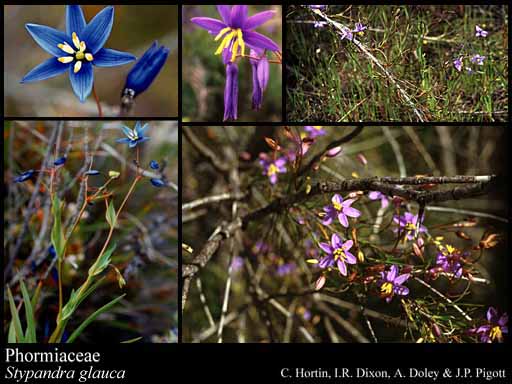This name is not current. Find out more information on related names.
- Reference
- Theoria Syst.Pl. 7-8 (1858)
- Name Status
- Not Current

Scientific Description
Family Sometimes included in Agavaceae.
Habit and leaf form. Sub shrubs, or herbs (medium to tall). Perennial; plants with a basal concentration of leaves, or with neither basal nor terminal concentrations of leaves; rhizomatous, or tuberous. Helophytic to xerophytic. Leaves medium-sized to very large; alternate; distichous; commonly leathery (or rigid); ambiguously petiolate to subsessile (by the edgewise compression at the blade/sheath junction), or sessile; sheathing. Leaf sheaths with free margins. Leaves edgewise to the stem to with ‘normal’ orientation (the sheath and the base of the blade very strongly compressed, the leaf almost or quite unifacial around the junction); simple. Leaf blades entire; flat, or folded; linear; parallel-veined; without cross-venules. Leaf blade margins often rough or serrulate with antrorse teeth. Stem anatomy. Secondary thickening absent.
Reproductive type, pollination. Fertile flowers hermaphrodite. Unisexual flowers absent. Plants hermaphrodite.
Inflorescence and flower features. Flowers aggregated in ‘inflorescences’; in panicles. The terminal inflorescence unit cymose. Inflorescences scapiflorous (often more or less), or not scapiflorous; terminal; sparingly to densely branched, few- to many-flowered panicles. Flowers small to medium-sized; regular to somewhat irregular; when irregular, somewhat zygomorphic. The floral asymmetry involving the perianth, or involving the perianth and involving the androecium. Flowers 3 merous; cyclic; pentacyclic. Perigone tube present (short), or absent. Perianth of ‘tepals’, or with distinct calyx and corolla (dubiously); 6; 2 -whorled; isomerous; petaloid (including the outer series); similar in the two whorls, or different in the two whorls (the outer often smaller, sometimes of different texture). Calyx (if the outer whorl so designated) 3; 1 -whorled; polysepalous, or gamosepalous; regular, or unequal but not bilabiate. Corolla (if the inner whorl so designated) 3; 1 -whorled; polypetalous, or gamopetalous; unequal but not bilabiate, or regular; green, or white, or yellow, or orange, or blue, or violet. Androecium 6. Androecial members free of the perianth; all equal, or markedly unequal; free of one another (usually), or coherent (rarely); when joined 1 - adelphous; 2 -whorled (3+3). Androecium exclusively of fertile stamens. Stamens 6; diplostemonous; alterniperianthial. Anthers dorsifixed, or basifixed; dehiscing via pores, or dehiscing via longitudinal slits; introrse; tetrasporangiate. Pollen shed as single grains. Gynoecium 3 carpelled. The pistil 3 celled. Carpels isomerous with the perianth. Gynoecium syncarpous; eu-syncarpous; superior, or partly inferior (slightly embedded, in Phormium). Ovary plurilocular; 3 locular. Gynoecium stylate. Styles 1; attenuate from the ovary; apical. Stigmas 1; dry type. Placentation axile. Ovules 4–30 per locule (to ‘rather numerous’); arillate, or non-arillate; anatropous.
Fruit and seed features. Fruit fleshy, or non-fleshy; dehiscent, or indehiscent; a berry (sometimes blue), or a capsule. Capsules loculicidal, or septicidal. Seeds endospermic. Endosperm oily. Seeds winged (Phormium), or wingless. Cotyledons 1. Embryo achlorophyllous (2/2). Testa encrusted with phytomelan (even in fleshy fruits). Seedling. Hypocotyl internode present. Mesocotyl absent. Seedling collar not conspicuous. Cotyledon hyperphyll elongated, or compact; assimilatory, or non-assimilatory; more or less circular in t.s. Coleoptile absent. Seedling cataphylls present. First leaf dorsiventral.
Geography, cytology, number of species. Holarctic, Paleotropical, Neotropical, Australian, and Antarctic. World distribution: Southeast Asia, Australia, Pacific Islands, New Zealand, with Dianella extending to Africa, Madasgascar and Mascarene Is. X = 8. About 30 species.